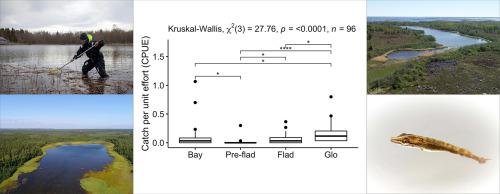Estuarine, Coastal and Shelf Science ( IF 2.8 ) Pub Date : 2021-06-23 , DOI: 10.1016/j.ecss.2021.107477 Annie Pursiainen , Lari Veneranta , Sanna Kuningas , Anniina Saarinen , Meri Kallasvuo

|
The Quark Archipelago, in the northernmost part of the Baltic Sea, provides valuable reproduction areas for coastal fish such as pike (Esox lucius L.). Here, pike stocks are still in good condition compared to the southern Baltic Sea, where pike stocks have declined. Hence, this area offers a unique opportunity to study the underlying causes of successful pike reproduction and to identify a productive pike reproduction habitat. This study suggests that the key factor defining suitable reproduction habitats for pike in the Quark Archipelago was the level of shelter. The more sheltered a habitat, in terms of morphology and level of isolation of the site and the site's exposure to wave action and shoreline density, the better the reproduction habitat was for pike. Gloes, which are the most isolated successional stages of coastal lagoons, represented the most sheltered habitat type and showed the highest pike larvae abundance. Additionally, sheltered bays and flads, less isolated successional stages of coastal lagoons compared to gloes, were also used as reproduction habitats by pike but with a lower abundance of larvae compared to the gloes. Gradually increasing salinity and the occurrence of sticklebacks (Gasterosteidae) reflected the morphology of the site. Pike larvae were observed in locations without sticklebacks and with low salinity. Pike larvae were found mostly amongst fallen reed (Phragmites australis) and in areas with moss (Fontinalis sp.) growth, which supports earlier findings. This study provides valuable new knowledge on larval pike habitats and highlights the significance of sheltered bays and gloes in the northern Baltic Sea. The information can be utilised for planning conservation and the restoration of pike reproduction habitats to protect and restore pike populations on both a regional and larger scale.
中文翻译:

越庇护越好——沿海海湾和泻湖是波罗的海北部梭鱼的重要繁殖栖息地
夸克群岛位于波罗的海最北端,为诸如梭鱼(Esox lucius)等沿海鱼类提供了宝贵的繁殖区L.)。与波罗的海南部的梭鱼库存下降相比,这里的梭鱼库存仍处于良好状态。因此,该区域提供了一个独特的机会来研究梭鱼繁殖成功的根本原因并确定梭鱼繁殖的高产栖息地。这项研究表明,在夸克群岛确定适合梭鱼繁殖栖息地的关键因素是庇护所的水平。栖息地的庇护所越多,就该地点的形态和隔离程度以及该地点对波浪作用和海岸线密度的暴露而言,繁殖栖息地就越适合梭鱼。Gloes 是沿海泻湖最孤立的演替阶段,代表了最受庇护的栖息地类型,并显示出最高的梭鱼幼虫丰度。此外,避风港湾和弗拉德,与 Gloes 相比,沿海泻湖较少孤立的演替阶段,也被梭鱼用作繁殖栖息地,但与 Gloes 相比,幼虫的丰度较低。逐渐增加的盐度和棘鱼(Gasterosteidae)的出现反映了该地点的形态。在没有刺鱼和低盐度的地方观察到梭鱼幼虫。梭鱼幼虫主要在倒下的芦苇中被发现(Phragmites australis)和苔藓(Fontinalis sp. )生长的区域,这支持了早期的发现。这项研究提供了有关幼鱼梭鱼栖息地的宝贵新知识,并强调了波罗的海北部避风海湾和洞穴的重要性。该信息可用于规划保护和恢复梭鱼繁殖栖息地,以在区域和更大范围内保护和恢复梭鱼种群。


























 京公网安备 11010802027423号
京公网安备 11010802027423号